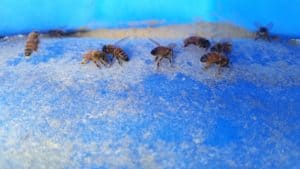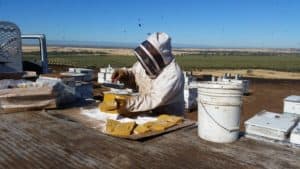Most beekeepers have come to realize that due to lack of natural forage in our urban and agricultural landscapes, feeding pollen substitute has become necessary to keep bees healthy in most parts of the country. Last summer was an especially challenging season in the West due to extremely hot and dry conditions. Despite a wet spring in California and Oregon last year, the spigot was shut off abruptly early in the summer and what little forage was available quickly shriveled. Beekeepers who had not been providing supplemental feed saw their colonies dwindle as the summer went on. Although it’s still early, this year is looking like it could be similar.

One strategy I have been seeing more of in recent years is bulk dry feeding of pollen sub. However, as with any beekeeping technique, there seems to be as many detractors as proponents. Most beekeepers still rely heavily on protein patties to speed build-up early in the spring and ensure well-fed fat winter bees as the weather cools. Dry pollen feeding is gaining adherents because of the following advantages.
First, a dry pollen feeder can be a welcome distraction for aggressive, “robby” foragers late in the summer. Rather than picking on each other, the bees can stay busy collecting the dry pollen. It’s more fun to see bees diving headlong into a pile of dry pollen sub rather than killing each other at the hive entrance while attempting to rob. The static charge on the bee’s body attracts the pollen grains which are then combed off and put into their corbicula (pollen baskets).

This brings me to the next advantage of dry feeding; unlike patties that are put into the hive, dry pollen sub is stored for later use. There is some disagreement about whether the artificial pollen ferments the same way and provides the same benefits as true bee bread, but at least it remains in the hive for later use. Protein patties are eaten directly and not stored, possibly because of the added sugar and soft consistency. Also, while patties are very attractive to small hive beetles, dry sub in a feeder is generally ignored by this pest.
For beekeepers who are short on time, feeding bulk dry pollen requires way less time and energy compared with putting on patties. It does not require the beekeeper to disturb each colony or lift any boxes. There are many dry pollen feeders on the market, but with an old barrel and a little ingenuity anyone can make one. Feeding the bees in this way just involves opening the bag of dry sub and dumping it in. For small scale beekeepers with a few hives, a simple feeder can be made from a plastic juice jug or other container set on its side with the bottom cut out.
I do not think dry pollen feeding can replace patties entirely, as there are some significant drawbacks to this method. First, the colonies will not collect dry pollen equally, and the beekeeper cannot control how much each hive is getting. Some colonies may go crazy for it while others may ignore it completely. With patties, the beekeeper can ensure that each colony is at least getting some protein. Another worry with dry pollen feeding is the chance of diseases being spread, which is also a concern with barrel feeding of sugar syrup. Wherever bees from different colonies are commingling, there is increased risk from bees defecating and dying in the feeder.

All in all, I think dry pollen sub feeding is a useful practice but not a total replacement for protein patties. During a pollen dearth or when robbing is a problem, it can be especially useful. As we learn more about bee nutrition, I expect better quality pollen supplements will be introduced into the market. This will go a long way in ensuring our bees have their nutritional needs met.